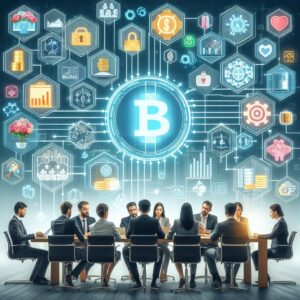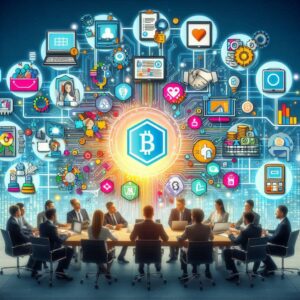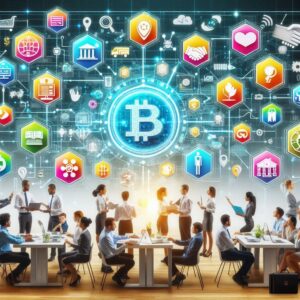The gaming industry has undergone a revolutionary transformation with the advent of blockchain technology, introducing a new paradigm where players can truly own their in-game assets. While traditional video games rely on centralized servers to manage player progress and virtual items, NFT gaming platforms utilize blockchain to provide verifiable ownership, scarcity, and interoperability of digital assets. This shift is redefining the relationship between players and game developers, turning gaming from a mere pastime into a potential economic opportunity.
NFTs (non-fungible tokens) initially gained traction as digital collectibles, but their application in gaming has unlocked unprecedented possibilities. By integrating NFTs, gaming platforms enable players to buy, sell, and trade in-game items across different ecosystems, ensuring that virtual assets hold real-world value. This innovation has given rise to new economic models, such as play-to-earn (P2E), where gamers can generate income through gameplay. As the NFT gaming sector continues to expand, it is crucial to explore its key benefits, applications, and challenges to understand its future trajectory.
NFT gaming platforms are fundamentally different from traditional gaming environments, as they integrate blockchain technology to enable players to truly own their in-game assets. While classic games rely on centralized servers to manage progress and inventory, NFT gaming platforms store these assets on decentralized blockchains. This not only ensures transparency and security but also allows for the creation of non-fungible tokens (NFTs), which are unique, verifiable digital items that can be bought, sold, and traded.
On NFT gaming platforms, players can acquire digital items—ranging from in-game characters to virtual real estate—that are represented as NFTs. These tokens cannot be replicated or exchanged on a one-to-one basis, which differentiates them from fungible assets like cryptocurrencies. This uniqueness provides players with a sense of true ownership over their virtual possessions, making their gaming experience more immersive and financially rewarding. Additionally, the use of blockchain ensures that every transaction involving these assets is transparent and secure.
Key Features of NFT Gaming Platforms:
- Decentralization: No central authority controls the assets; everything is recorded on a blockchain.
- True Ownership: Players own their in-game assets and can transfer, sell, or trade them freely.
- Interoperability: Assets can often be used across different games or platforms that support the same blockchain standards.
- Transparency: Every transaction involving NFTs is recorded on the blockchain, ensuring transparency and traceability.
NFT gaming platforms can also integrate other decentralized financial elements, such as play-to-earn models or tokenized economies, creating a dynamic and evolving ecosystem where players are incentivized to continue playing and trading. These elements form the backbone of the NFT gaming industry, providing both entertainment and economic value to participants.
Key Benefits of NFT Gaming
The integration of NFTs into gaming platforms has unlocked several important benefits, not just for game developers but also for players. The most significant advantage is the ability to offer players real ownership of in-game assets, ensuring that their time and investments in the game are not wasted. However, these platforms also bring about greater player engagement, new revenue models, and the possibility for cross-platform asset trading. Below are some of the key benefits that have contributed to the rise of NFT gaming.
Ownership and Authenticity
- True Ownership: Players can now own in-game assets permanently, independent of the game’s lifecycle.
- No Centralized Control: Assets are owned by the player, not by the game developers, meaning they are not at risk of being removed or altered without the player’s consent.
- Unique & Authentic Assets: The NFTs are verifiable, ensuring that players can confirm the authenticity and rarity of their digital items.
Enhanced Player Engagement
- Player Retention: By incorporating play-to-earn (P2E) mechanics, NFT gaming platforms incentivize long-term player engagement, ensuring players feel invested not only in the game’s story or mechanics but also in the potential for financial gain.
- Community Building: NFT games often foster vibrant communities around shared interests, such as creating or collecting specific types of NFTs.
- Incentives for Loyalty: Through rewards, governance tokens, and other incentives, platforms can encourage players to become brand ambassadors, promoting the game and its assets to a wider audience.
Economic Opportunities
- Play-to-Earn Models: Players can earn tokens or NFTs as rewards for their time and skill, which can be exchanged for real-world value.
- New Revenue Streams for Developers: In addition to upfront game purchases, developers can earn ongoing revenue through transaction fees, secondary sales of in-game assets, and other blockchain-based monetization methods.
- Asset Trading: Players can sell their in-game assets in marketplaces, turning their gaming achievements into income-generating opportunities.
Diverse Applications Beyond Collectibles
NFT gaming platforms are not limited to the sale and exchange of virtual items—there are several other innovative applications that are redefining the gaming experience. These applications go beyond the traditional concepts of in-game items and digital collectibles, and extend into the realm of virtual economies, spaces, and collaborative creation. Let’s take a closer look at some of the most exciting and transformative uses of NFTs in gaming.
Virtual Real Estate
- Ownership of Virtual Land: Many NFT games offer players the opportunity to buy, sell, and trade virtual land. This land is often used to build structures or host in-game events, offering players a chance to shape the game world themselves.
- Investment Potential: As virtual worlds become more expansive, owning virtual real estate could become a highly valuable asset. Land in popular games can increase in value, creating a real estate market within the game.
- Monetization: Players can generate income by hosting events, building experiences, or leasing their virtual land to other players, creating an entire economy within the game.
Interoperability Across Games
- Cross-Platform Use: NFTs can be used across multiple games that share the same blockchain protocol, allowing players to transfer assets and experiences seamlessly.
- Shared Ecosystems: Imagine owning an in-game item in one game that can be used in another, whether it’s a weapon, character skin, or vehicle. This interoperability creates a broader and more connected virtual universe.
- Collaborative Play: Cross-game interoperability enables collaborative efforts between game developers and players, as assets or characters from different games can be combined into a unified experience.
Community-Driven Content Creation
- Creation of Unique Experiences: Some NFT games allow players to create and sell their own content, such as skins, maps, or mini-games. This fosters creativity and ownership over not just the assets but the broader game experience.
- Player-Driven Economies: As players create more content, they fuel a player-driven economy where the community contributes to the overall growth of the game’s ecosystem.
- Revenue Sharing: Players can earn revenue from the sale of their user-generated content, allowing for new monetization channels beyond traditional gaming.
Challenges and Considerations
While NFT gaming platforms offer numerous advantages, there are several challenges that need to be addressed in order for the industry to reach its full potential. These challenges include scalability issues, regulatory hurdles, and the volatility of digital assets, all of which can impact the long-term viability of NFT gaming. Below are some of the primary concerns surrounding NFT gaming platforms today.
Scalability Issues
- Blockchain Limitations: Current blockchain technology, while revolutionary, faces scalability challenges. High transaction fees and slow processing times can become an issue during peak usage periods, reducing the efficiency of gaming platforms.
- Network Congestion: Popular games with large user bases can strain blockchain networks, leading to delays or the inability to process transactions in real-time.
- Energy Consumption: Proof-of-work blockchains, in particular, are often criticized for their environmental impact due to high energy consumption.
Regulatory Concerns
- Legal Uncertainty: The regulatory environment surrounding NFTs and cryptocurrencies is still evolving, and governments around the world are grappling with how to approach digital assets in the context of taxation, ownership rights, and financial regulations.
- Intellectual Property Issues: The ownership and use of digital assets on blockchain networks can raise concerns about intellectual property rights, especially when it comes to user-generated content.
- Consumer Protection: As with any new technology, there are concerns over consumer protection, especially in a space that combines gaming, digital assets, and finance.
Market Volatility
- Cryptocurrency Volatility: Many NFT gaming platforms rely on cryptocurrency to facilitate transactions. The volatility of the cryptocurrency market can create instability in asset prices, which might deter players from investing in the long term.
- Speculative Nature: The value of NFTs can fluctuate significantly based on demand, trends, or speculation, making them a risky investment for players looking to profit.
Future Outlook
Looking ahead, the future of NFT gaming platforms is bright, with a rapidly expanding market and numerous possibilities for innovation. As blockchain technology continues to mature, it is expected that many of the current limitations—such as scalability issues and high fees—will be addressed, creating a more seamless and user-friendly experience for gamers. Additionally, as NFT gaming platforms grow in popularity, it is likely that the integration of other technologies, such as the metaverse, will further enhance the gaming experience.
Potential Developments:
- Enhanced Blockchain Networks: More efficient blockchain networks, such as those utilizing proof-of-stake (PoS) or other eco-friendly consensus mechanisms, will lower transaction costs and improve scalability.
- Mainstream Adoption: As NFTs gain more recognition and acceptance, gaming companies will likely incorporate NFTs into mainstream titles, making them more accessible to a broader audience.
- Cross-Reality Experiences: The merging of virtual gaming and physical reality, including augmented reality (AR) and virtual reality (VR), could open up new opportunities for NFT integration, creating truly immersive experiences for players.
NFT gaming platforms are on the brink of an exciting new era, and those who adapt early to these changes will have the opportunity to shape the future of the gaming industry. The expansion of NFT gaming and its integration into larger ecosystems will drive innovation and create new revenue models for players, developers, and investors alike.
Conclusion
The rise of NFT gaming platforms signals a fundamental shift in how digital assets are created, owned, and traded within virtual worlds. By leveraging blockchain technology, these platforms empower players with unprecedented ownership rights, financial opportunities, and creative freedom. However, challenges such as scalability, regulatory concerns, and market volatility must be addressed to ensure sustainable growth and adoption. Despite these hurdles, the potential of NFT gaming remains immense, promising a future where digital economies flourish and player-driven experiences take center stage.
As technology advances, the intersection of gaming, blockchain, and the metaverse will continue to evolve, opening doors to new innovations. Whether through play-to-earn mechanics, virtual real estate, or cross-platform interoperability, NFT gaming is set to reshape the industry in ways previously unimaginable. Game developers, investors, and players alike must stay informed and adapt to these changes to fully capitalize on the opportunities presented by this transformative trend.



